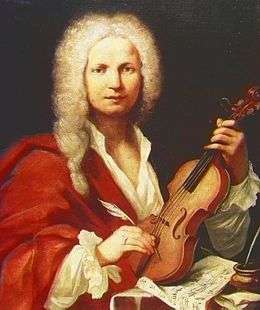Grosso mogul
Grosso mogul, also Il grosso mogul, or capitalised [Il] Grosso Mogul ([The] Great Moghul), RV 208, is a violin concerto in D major by Antonio Vivaldi.[1][2][3] The concerto, in three movements, is an early work by the Venetian composer.[4] Around the mid-1710s Johann Sebastian Bach transcribed the concerto for organ, BWV 594, in C major.[5] A simplified version of the violin concerto, RV 208a, without the elaborated cadenzas that appear in manuscript versions of RV 208, and with a different middle movement, was published around 1920 in Amsterdam as concerto #11 of Vivaldi's Op. 7.[4]

History
Vivaldi's violin concerto in D major, RV 208, survives in three manuscripts:[6][7]
- Vivaldi's autograph score, conserved in Turin.
- A copy of the parts, conserved in the Landesbibliothek Mecklenburg-Vorpommern Günther Uecker in Schwerin.[3][4]
- Another copy of the parts conserved in Cividale del Friuli.[4]
The Grosso Mogul title appears on the Schwerin manuscript, which was written before 1717.[3][4][7][8] According to Michael Talbot, the name of the concerto can possibly be linked to Domenico Lalli's Il gran Mogol opera libretto, a setting of which had been presented in Naples in 1713.[4][9][10] Later settings of this libretto include Giovanni Porta's, staged in Venice in 1717, and Vivaldi's RV 697 (1730).[11][12][13][14]
The Schwerin and Cividale del Friuli copies of the concerto contain two variants of extended cadenzas for unaccompanied violin, in the first and last movements of the concerto.[4][5][8] The autograph version indicates where such cadenzas can be inserted in these movements, but does not contain the cadenzas.[8] A manuscript with the written-out cadenzas must have been circulating before c. 1713–1714 when Bach transcribed such version for solo organ (BWV 594).[5][7][8]
An earlier version of the concerto, RV 208a, was probably composed by c. 1712–1713.[7] This version has a different middle movement than the RV 208 version.[7][8] Vivaldi seems to have had no supervision over the Op. 7 collection, published around 1720 in Amsterdam by the Roger firm, in which the older RV 208a version of the concerto was retained.[7] This version of the concerto does not contain the extended cadenzas, nor an indication where such cadenzas could be inserted.[15]
Movements
The concerto has been transmitted in a version for violin soloist, strings (two violin parts and one viola part), and basso continuo.[3] It has three movements:[3]
- Allegro,

- Recitative: Grave,

- Allegro, 3
4, D major
First movement
The first movement, in D Major is in Ritornello form. The first solo episode consists of sixteenth notes, with double stops on every beat.
Second movement
The second movement, in B Minor is for the solo violin and basso continuo. There are strange rhythms, like improvisation.
Third movement
The third movement, in D Major, is in Ritornello form, and is the most virtuosic of the 3 movements.
Reception
References
- Brover-Lubovsky 2008, p. 61.
- Talbot 2011, pp. 92, 211.
- RISM No. 240005251
- Talbot 2011, p. 92.
- Dirksen 1992, p. 164.
- Heller 1997, pp. 73–74.
- Rasch 2017, p. 257.
- Heller 1997, p. 74.
- Il gran Mogol : drama per musica / di Domenico Lalli ; da rappresentarsi nel Teatro di S. Bartolomeo nel giorno 26. di decembre 1713 ; dedicato alla grandezza impareggiabile dell'Eccellentiss. signor conte VVirrico di Daun, vicerè, e capitan generale in questo regno di Napoli, &c. at Trove website.
- Carlo Antonio de Rosa marchese di Villarosa (1840). Memorie dei compositori di musica del regno di Napoli: raccolte dal marchese di Villarosa. Naples: Stamperia reale, p. 110.
- Talbot 2011, pp. 25, 92.
- RISM No. 212008590
- Mus.2444-F-1 at Saxon State and University Library Dresden website
- Freeman, Daniel E. (1995). "Antonio Vivaldi and the Sporck Theater in Prague", pp. 117–140 in Janáček and Czech Music: Proceedings of The International Conference (St. Louis 1988). Pendragon Press. ISBN 094519336X, pp. 122, 129.
- Heller 1997, p. 73.
Sources
- Brover-Lubovsky, Bella (2008). Tonal Space in the Music of Antonio Vivaldi. Bloomington: Indiana University Press. ISBN 978-0-253-35129-6.CS1 maint: ref=harv (link)
- Dirksen, Pieter (1992). "The Background to Bach's Fifth Brandenburg Concerto". The Harpsichord and its Repertoire: Proceedings of the International Harpsichord Symposium, Utrecht, 1990. Utrecht: STIMU Foundation for Historical Performance Practice. pp. 157–185. ISBN 9072786033.CS1 maint: ref=harv (link)
- Heller, Karl (1997). Antonio Vivaldi: The Red Priest of Venice. Hal Leonard. ISBN 1574670158.CS1 maint: ref=harv (link)
- Rasch, Rudolf (2017). "La famosa mano di Monsieur Roger: Antonio Vivaldi and his Dutch Publishers". In Talbot, Michael (ed.). Vivaldi. Routledge. pp. 241–290. ISBN 9781351537315.CS1 maint: ref=harv (link)
- Talbot, Michael (2011). The Vivaldi Compendium. Boydell Press. ISBN 9781843836704.CS1 maint: ref=harv (link)
External links
- Violin Concerto in D major, RV 208 (Vivaldi, Antonio), Organ Concerto in C major, BWV 594 (Bach, Johann Sebastian), 12 Concerti, Op.7 (Vivaldi, Antonio): Scores at the International Music Score Library Project (IMSLP)
- Concerto III in C Major (BWV 594) for Flute & Strings • Vivaldi Concerto for Violin in D RV208a: Scores at MuseScore website